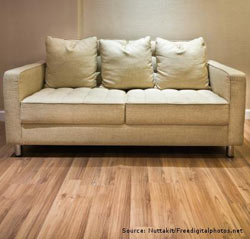Finding a rip or tear on your favorite chair doesn"t mean you have to leave it at the curb the next morning. You can repair upholstery on your furniture yourself without having to bring it to a professional-which can leave you with an empty wallet and without a chair for a few days.

Learning how to repair the upholstery on your furniture isn"t as hard as you might think. By dedicating an afternoon, you"ll be sitting pretty in no time. Having to repair the upholstery also gives you an opportunity to update your furniture"s look. You may decide that you want to change the fabric entirely, or add a colorful patch to cover the damage.
Busted Seams
If the seam on a cushion has ripped open, a few minutes with a needle and thread is all you"ll need to repair the sofa cushion and make it as good as new.
You"ll need:
- Strong nylon thread in a coordinating color
- Curved needle - packaged as a "mattress needle" or "upholstery needle"
- OPTIONAL: Fray check - This product is a clear liquid that helps stop fraying by hardening the edge of the fabric.
- Take a look at the rip and study it for a moment. If one side is intact and the other is fraying, you"ll need to address that first. If both sides are clean tears and there is no fraying, then skip to step 3.
- On the side that is fraying, apply a bead of the fray check along the length of the frayed edge and fold the fabric over so that the frayed edge will be tucked underneath. Give yourself enough space so the fraying isn"t too close to the line you"re about to hand-stitch.
- After you"ve folded the fabric over and created a straight edge, pinch together the two pieces of fabric and begin stitching them together with the nylon thread. The first stitch should begin at the back of the non-frayed side to hide your knot on the inside of the cushion.
- Continue to pinch the fabric together as you stitch until the rip is completely closed. To create a smooth seam, gradually pinch less and less fabric until the new seam joins with the old.
- Trim your excess thread after tying a knot and your cushion will be good as new!
TIP: Keeping stitches small and close together will help hide your repair. Couches with textured fabrics will hide stitches better also.
Holes
Sometimes, holes happen. Whether it"s from fabric weakening over time, damage from moving or anything else, there"s still a way to repair the upholstery.
- Fabric
- If you have the same type and color fabric it"s recommended to cut out and patch the hole. It may be more noticeable but it is the easiest and most affordable option.
- Leather
- Cut off any jagged edges and wipe the area with a cloth or paper towel lightly dampened with rubbing alcohol. This will remove any built up dirt and oils on the leather that could interfere with the repair process.
- Using a leather repair kit, follow the manufacturer"s directions and mix the filler compound.
- Use a layer of the leather filler inside the area where the hole is using the spatula provided in the kit. Blow dry the first coat of leather filler and once it"s dry, apply another layer of the filler. DO NOT dry this layer, the stickiness will allow the patch to bond it better.
- Apply a patch using a small amount of glue around the perimeter of the hole and press firmly around the edges of the patch to make sure it bonds properly.
- After the patch is in place, place a heavy object on the patch to make sure it doesn"t lift and allow it to sit for about two hours.
- Use leather protector on the patch and allow it to dry for one hour.
- Once the protector is dry, apply leather color to the patch. Soak a cloth in leather color and then wipe it over the patch. Be sure to wipe in one motion. Blend it into the rest of the leather so that it"s not noticeable.
- Be gentle with your couch! You don"t want to end up ripping the patch you just did, so it"s important to keep sharp objects and pets with claws away from your newly repaired leather chair.
If your couches are beyond an at-home repair then taking them to a professional will always be your best bet. However, if you"re looking to save a few bucks and have an afternoon free, then why not try and do it yourself?
The next time you plan on moving, make sure to hire professionals to move your stuff if you need the extra help. Your items will be packed and moved to prevent damage and will save you the trouble of making repairs yourself.